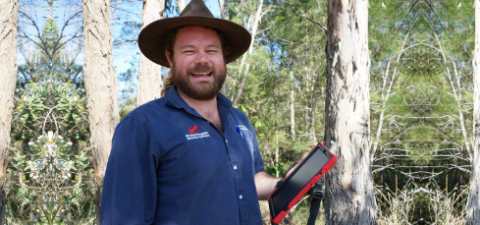Download high-quality fire ant photos and videos to help raise awareness and support eradication efforts.
On this page

Copyright
Do you have a website, social media channel, newsletter or print publication, and want to share fire ant-related messaging?
You can download and use our high-quality photos or videos freely with the following credit.
Photo/video credit: National Fire Ant Eradication Program
Fire ant facts
Fire ants are smart, highly adaptive and can survive in a range of climates.
Below are key facts about fire ants to complement your chosen image or video:
- Fire ants are copper brown in colour with a darker abdomen and measure 2–6 mm in size. Fire ants appear in a variety of sizes in one nest, making them easy to identify against other ant species.
- Fire ant nests appear as mounds or flat patches of loose soil with no obvious entry and exit holes.
- Fire ant nests are usually found in open areas such as lawns, garden beds, near water sources, along roadsides and in newly developed areas with disturbed soil.
- One fire ant nest that goes undetected can multiply and spread, putting an entire community at risk.
- Fire ants can be reported anytime at fireants.org.au or by calling 132 ANT (13 22 68). Take a photo of the nest and ants and report within 24 hours.
- Fire ants spread by travelling over and underground, flying up to 5 km, rafting on waterways after floods and hitchhiking in organic materials moved by people.
- Fire ants have a painful sting that can cause severe and potentially fatal allergic reactions in humans and animals.
- Fire ants are a destructive pest that can severely impact our way of life and living in the great outdoors. They can destroy crops, damage electrical equipment, kill pets and livestock, damage native ecosystems and render parks, playgrounds and backyards unusable.
- We must work together to fight fire ants, if they win it will cost the Australian economy $2 billion per year, forever.
Images
Fire ants

Extreme close-up of fire ant—landscape image (3473 x 2480 pixels)
JPG, 5.99MB

Fire ant on sand—landscape image (2888 x 1925 pixels)
JPG, 2.63MB

Various sizes of fire ants on key—landscape image (4896 x 3264 pixels)
JPG, 8.66MB

Various sizes of fire ants on 10 cent coin—landscape image (2258 x 1572 pixels)
JPG, 0.98MB

Fire ant workers and alates—landscape image (2592 x 1728 pixels)
JPG, 3.65MB

Fire ants attacking an insect—landscape image (4032 x 3024 pixels)
JPG, 2.05MB

Fire ants eating crops—landscape image (2592 x 1728 pixels)
JPG, 1.93MB
Fire ant nests

Immature fire ant nest—landscape image (3072 x 2048 pixels)
JPG, 1.90MB

Large nest in a garden bed—landscape image (3968 x 2976 pixels)
JPG, 2.77MB

Fire ant nest in water meter box—landscape image (3968 x 2976 pixels)
JPG, 5.64MB

Small fire ant nest next to a footpath—landscape (2592 x 1728 pixels)
JPG, 2.45MB

Fire ant nest against a letterbox—landscape image (3968 x 2976 pixels)
JPG, 3.58MB

Multiple fire ant nests on a rural property—landscape image (4000 x 3000 pixels)
JPG, 4.00MB

Fire ant nest at the base of a hay bale—landscape image (4000 x 3000 pixels)
JPG, 3.15MB

Diagram of fire ant nest structure—landscape graphic (4000 x 3000 pixels)
JPG, 662KB
Videos
Poking a fire ant nest with a metal stick—landscape video
Run time—01:28 (this video has no sound)
Video format—MP4, 74.5MB
Swarming fire ants, alates and brood—landscape video
Run time—00:24 (this video has no sound)
Video format—MP4, 45.8MB
Fire ants attacking green ants—portrait video
Run time—00:27 (this video has no sound)
Video format—MP4, 64.9MB


